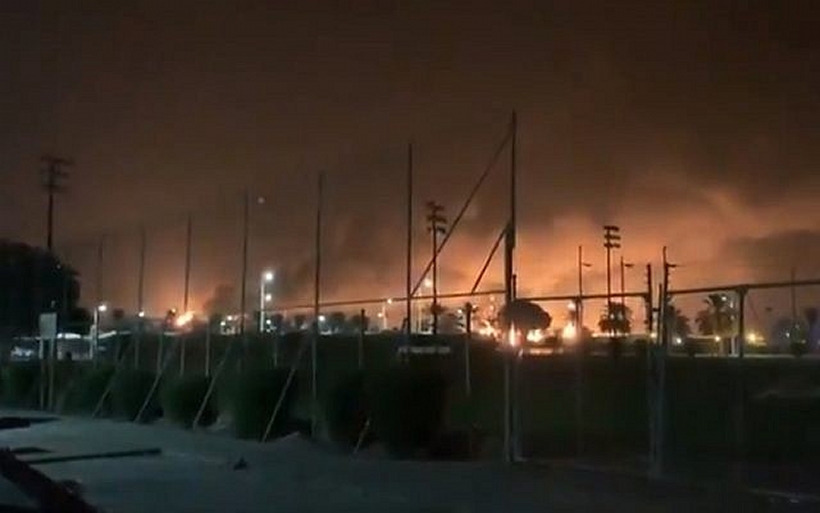Mon 16 September 2019:
Saturday’s strikes on petroleum and gas processing plants in Khurais and Abqaiq, which Yemen’s Iran-allied Houthi rebels have claimed responsibility for, knocked down around 5.7 million barrels per day (bpd) of total Saudi oil output.
Yahya Saree, a Houthi spokesman, told the rebel-backed Al Masirah TV based in Beirut that the Aramco attacks were carried out by the use of 10 drones and in “cooperation with the honourable people inside the [Saudi] kingdom,” suggesting the possible involvement of beleaguered Shia dissidents living in the oil-rich Eastern Province.
In this account of events, armed drones would have had to fly over 1,000 kilometres (621 miles) from Houthi-controlled territory in northwest Yemen across Saudi Arabia to reach their targets in Abqaiq.
Another possible route for the aerial vehicles could be a trajectory starting in northeast Yemen near the border with Oman and travelling northbound through areas close to the United Arab Emirates and Qatar before they could deliver the explosive projectiles.
But analysts said either scenario might be contested from an operational perspective, considering the Houthis’ likely lack of access to such advanced aerial attack systems, the vast geographical distance from the point of departure to the destination in question, and lastly the heavy air defence fortifications in place along the supposed flight route.
This raises the possibility of strikes on Aramco oil plants originating in south Iraq, which lies much closer to the Abqaiq and Khurais facilities and where Iran-backed Popular Mobilisation Forces (PMF, or Hashd al-Shaabi) positions recently came under suspected Israeli attacks. Israel has neither confirmed nor denied being behind those attacks.
In late June, US officials concluded that an earlier May 14 drone strike on Aramco’s East-West pipeline near the central town of al-Duwadimi – which the Houthis also claimed responsibility for – was launched from Iraq, not Yemen, implicating Tehran-allied Shia militias.
According to people familiar with the assessment, wreckage from Saturday’s assaults indicated employment of a different model of drones and explosives than those witnessed in previous Houthi offensives within Saudi territory.
On Sunday, a day after the Aramco attacks, Middle East Eye quoted an unnamed senior Iraqi intelligence official as saying that the operation was conducted from inside Iraq in reprisal for suspected Israeli drone strikes against PMF bases. Iraq has denied the drone attack came from there.
“In both cases, Houthi or Hashd, there is an autonomous motive in addition to any links with Iran, as the former suffered from American support for the Saudi-led military campaign in Yemen, while the latter suffered a number of air strikes recently,” Erwin van Veen said.
“It is worth bearing in mind though that Houthis have more agency than some of the Iran-affiliated Hashd groups in Iraq such as Kata’ib Hezbollah, Kata’ib Sayyid al-Shuhada and Kata’ib Imam Ali, and plenty of motivation regardless of Iran.”
Another scenario, suggested by US and Saudi authorities, points to the Iranian Revolutionary Guards directly targeting Aramco petroleum facilities with cruise missiles launched from Iraqi or even Iranian territory.
Such a course of action does not generally dovetail with Tehran’s regional security strategy of indirect and asymmetric engagement with conventionally superior adversaries while maintaining optimum “plausible deniability”.
Think your friends would be interested? Share this story!





